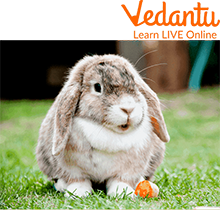




Interesting Facts About Rabbits To Know (2025)
Rabbits are fascinating creatures widely known for their long ears, quick movements, and social nature. Whether found in the wild or kept as pets, these small mammals have many unique traits and play an important role in ecosystems. This page explores the key facts about rabbits in a clear, reliable format for students and animal lovers, providing answers to common questions and offering visuals to deepen understanding.

What is a Rabbit?
A rabbit is a small, herbivorous mammal belonging to the family Leporidae, order Lagomorpha. Rabbits are easily recognized by their long ears, powerful back legs, and soft, fluffy tails. Unlike rodents, rabbits have a unique dental structure and dietary needs. There are currently about 17 recognized species of rabbits worldwide, with over 30 breeds of domestic rabbits.
Where Do Rabbits Live?
Rabbits are highly adaptable and live in a wide range of habitats, including grasslands, forests, meadows, wetlands, mountains, and even some deserts. They are ground dwellers and prefer areas where they can dig and hide from predators. Wild rabbits typically create complex burrow systems called warrens that provide shelter and multiple exits for safety.


Warrens can extend up to 3 meters (about 10 feet) deep and contain several chambers and tunnels. This structure allows rabbits to live safely in groups, which improves their chances of surviving threats from predators.
What Do Rabbits Eat?
Rabbits are strictly herbivores. Their diet mainly consists of grasses, leaves, herbs, and sometimes vegetable roots and barks. Wild rabbits forage during dawn and dusk (crepuscular) to avoid predators and extreme temperatures.
- Wild diet: fresh grasses, leafy weeds, clovers, roots, and tree bark.
- Pet rabbit diet: mainly hay (such as timothy or alfalfa), fresh greens, and limited pellets.
Note: Iceberg lettuce is not recommended as it can cause digestive issues.
Rabbits need a high-fibre diet to keep their digestive system healthy and prevent their ever-growing teeth from becoming too long.
Rabbit Anatomy & Unique Features
- Rabbits possess two pairs of upper front teeth, one pair right behind the other, which is a key difference from rodents.
- Their ears can be up to 10 cm (about 4 inches) long and can rotate almost 180 degrees to detect sounds and predators.
- Weight can range from 1 to 7 kg (2–15 lbs) depending on the breed and species.
- Newborn rabbits (kits) are born hairless and with their eyes closed, unlike hares which are born fully furred.
- Their eyes are positioned on the sides of their head, giving almost a 360-degree field of vision—useful for spotting threats.
- Known for their hind leg strength, rabbits can jump up to 90 cm (3 feet) high in a single leap.

How Do Rabbits Behave?
Rabbits are naturally social animals and often live in groups (sometimes called a "herd"). They use body language and sounds to communicate. Happy rabbits might leap and twist in the air (called a binky), while content ones sometimes "purr" by gently grinding their teeth. Rabbits are prey animals and rely on speed, camouflage, and alertness for survival.

Classification of Rabbits
| Taxonomic Rank | Name |
|---|---|
| Kingdom | Animalia |
| Phylum | Chordata |
| Class | Mammalia |
| Order | Lagomorpha |
| Family | Leporidae |
Interesting Rabbit Facts (2025 Edition)
- A baby rabbit is called a kit or kitten; female is a doe; male is a buck.
- Rabbits' teeth never stop growing—constant chewing keeps them the right length.
- They can perform "binky" jumps—twists in the air—to show excitement.
- Rabbits often thump their hind legs to warn other rabbits of danger.
- Mother rabbits feed their young only once or twice a day to avoid attracting predators.
- One of the world’s most famous cartoon rabbits is Bugs Bunny!
In summary, rabbits are remarkable mammals with adaptations for survival in varied habitats. Their behaviour, diet, and physiology offer valuable lessons for biology and environmental science. To discover more about animal biology or for festival essays and speeches, explore Vedantu’s EVS section and essay collection. For insights on wildlife protection, see our detailed page on World Wildlife Day.
FAQs on Facts About Rabbits: Habitat, Diet, Behavior and More
1. Where do rabbits typically live?
Rabbits live in a variety of environments, including meadows, forests, grasslands, and deserts. They are known for digging complex systems of tunnels and rooms underground called burrows. A large, interconnected network of these burrows where a group of rabbits lives is called a warren.
2. What kind of food do rabbits eat?
Rabbits are herbivores, which means their diet consists entirely of plants. In the wild, their main food sources include:
- Fresh grasses
- Weeds and wildflowers
- Clover
- Leafy plants
3. What are baby rabbits called?
Baby rabbits are called kits or sometimes kittens. A mother rabbit gives birth to a group of kits at one time, which is known as a litter. Kits are born blind, hairless, and completely dependent on their mother for care.
4. Why do rabbits have such long ears?
A rabbit's long ears serve two crucial purposes for survival. Firstly, they act like large antennas that can rotate independently to catch faint sounds from predators from any direction. Secondly, the large surface area of their ears is filled with blood vessels that help them regulate their body temperature by releasing excess heat to cool down.
5. How do rabbits protect themselves from predators like foxes or hawks?
Rabbits have several clever adaptations to escape danger. Their powerful hind legs allow them to run at high speeds in a zigzag pattern to confuse pursuers. They also have a wide field of vision to spot threats early. If a rabbit senses danger, it will thump its hind leg on the ground to alert other rabbits in the warren.
6. What is the difference between a rabbit and a hare?
While they look similar, rabbits and hares are different species. Key differences include:
- Birth: Rabbits (kits) are born helpless, without fur and with their eyes closed. Hares (leverets) are born fully furred with their eyes open.
- Home: Rabbits live in social groups in underground burrows. Hares are more solitary and live in simple nests above ground.
- Appearance: Hares generally have longer ears and larger hind legs than most rabbit species.
7. Are carrots the main food for rabbits, as seen in cartoons?
This is a common misconception. While rabbits can eat carrots, they are very high in sugar and should only be given as a small, occasional treat. A rabbit's primary and most important food is hay and grass. Eating too many carrots can be unhealthy for a rabbit.
8. Why do rabbits constantly twitch their noses?
A rabbit's nose twitching is a key part of its sense of smell. The rapid movement helps expose the millions of sensory receptors in its nose to the air, allowing it to better detect scents of food, other rabbits, and potential predators. A fast-twitching nose often indicates a rabbit is alert or curious about its surroundings.
9. What are some interesting facts about a rabbit's behaviour?
Rabbits have unique behaviours that show how they feel. For example:
- When a rabbit is very happy and excited, it performs a joyful leap and twist in the air called a 'binky'.
- They are crepuscular, meaning they are most active during dawn and dusk.
- They are very social animals and communicate with each other through body language and soft sounds.









